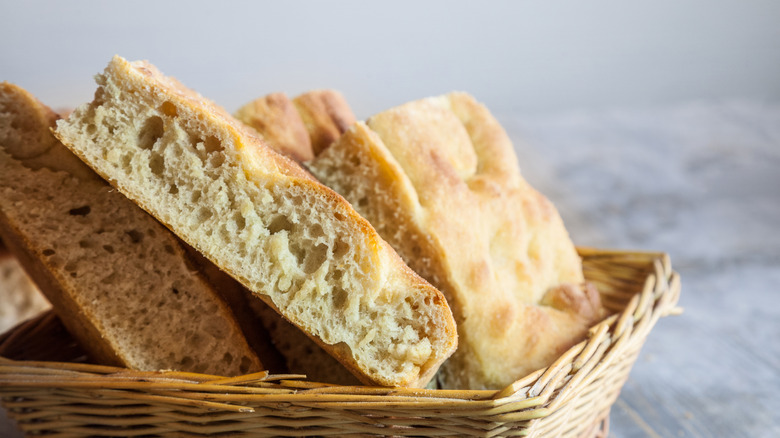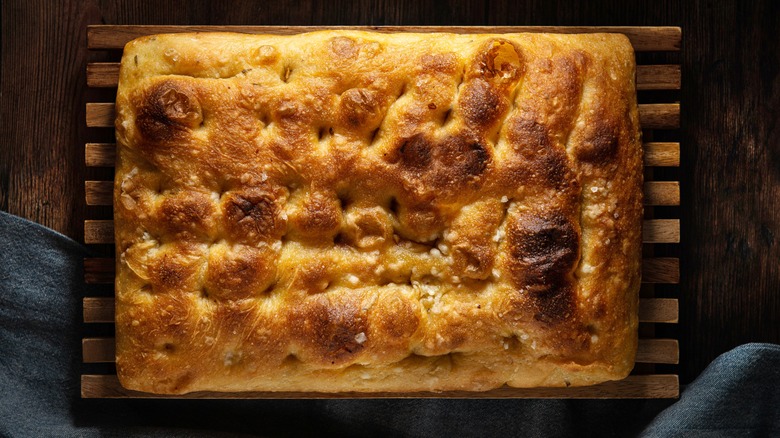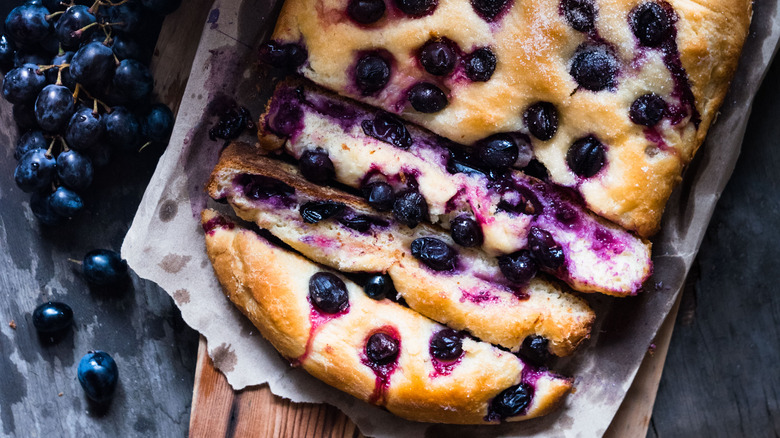Schiacciata: The Tuscan Flatbread That's Sure To Up Your Appetizer Game
Tuscany is a culinary wonderland. Metaphorically feast your eyes on the Arno while literally feasting on the region's mainstays. Truffle-laced pasta, Florentine steak, and vegetable-filled ribollita soup are essentials on any Tuscan menu, per Italy Foodies, though don't discount the region's bread. Generally, Tuscan dough yields crusty, salt-free bread, according to MasterClass. Traditional Tuscan bread is fluffy and chewy, though it isn't particularly noteworthy or flavorful on its own. Once you use it on a sandwich or dip the crust in leftover pasta sauce, the bread takes on a whole new complexity.
Yet for a bread that stands out solo as well as sandwiched, you'll want to look beyond Tuscan bread to the region's olive-oil-based flatbread. A cousin of the better-known focaccia, schiacciata translates to "flattened" or "squashed" (via Italy Magazine). Schiacciata bread is enjoyed similarly to focaccia — hello, prosciutto sandwiches — but it's a unique entity with its origin story and sweet and savory spin-offs.
Thank the peasants for this traditional taste of Tuscany
Tuscan schiacciata originated as peasant fare, per La Cucina Italiana. It was originally cooked on a fire-heated stone and only moved to the oven around the Middle Ages. At first, schiacciata was used as a test bread to determine whether an oven was hot enough for other, more standard loves of bread. Not to be discarded, the flatbread eventually emerged as its own entity.
Since the Middle Ages, schiacciata has grown and expanded. According to a 2014 survey cited by La Cucina Italiana, roughly 617 names for schiacciata exist. The variations are similarly all-encompassing, from the ultra-crispy to the extra fluffy. If you've ever been to Florence, chances are you've come across schiacciata in one way or another. The famous panini shop, All'antico Vinaio, uses schiacciata as a sandwich base. Between two perfectly crisped halves of the bread are the likes of truffle cream, stracciatella cheese, and thin slices of meat.
Schiacciata is a thinner, chewier focaccia with less water and a deeper crisp
Don't let the appearance fool you. Focaccia and schiacciata use similar ingredients but are not at all identical. Schiacciata holds its own place and taste in the Italian canon. According to MasterClass, Tuscan schiacciata is not as fluffy or spongy as focaccia. Rather, it's flatter and shorter bread made from its ratio of like ingredients: salt, flour, yeast, olive oil, and water.
This flattened state results from the rising process and water content called for by most schiacciata recipes. Unlike focaccia, which often requires multiple, prolonged rising periods, schiacciata is made with only one rise and a subsequent smashing of the dough. When coupled with schiacciata's lower level of hydration, that process lends itself to a crispier bread (per Food52). Herein lies the solution for focaccia sandwiches that are too stuffed to try in one bite. Simply swap in schiacciata, and you'll consolidate your bread enough for a well-rounded bite.
Topping variations range from the savory to the surprisingly sweet
Because schiacciata doesn't stray too far from focaccia, you can similarly enjoy the bread. Try schiacciata for your next mortadella sandwich, or warm up a piece in the oven for a very Tuscan breakfast. If you're hosting a dinner party, schiacciata makes for a great and aesthetically pleasing appetizer, particularly when topped with herbs, olives, or cheese. You can even cut a schiacciata sandwich into bite-sized pieces for a Tuscan take on finger food.
Unlike focaccia, however, schiacciata has a different, surprising use that is not typically seen with bread. Schiacciata con l'uva — schiacciata with grapes– is a signature Tuscan dessert or snack, per Taste Atlas. It's an autumnal flatbread that celebrates Tuscany's grape harvest and decorates the oil-based bread with a colorful and sweet twist. If you've never tried schiacciata with grapes, the addition of fruit may seem strange. However, grapes work surprisingly well and can be topped on savory pizzas. Keep schiacciata on the back burner for the next time you're craving a taste of Tuscany or have leftover grapes ready to be repurposed.



